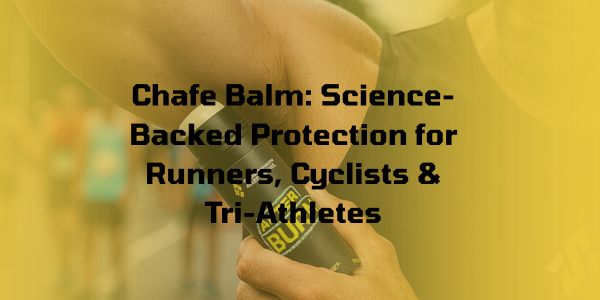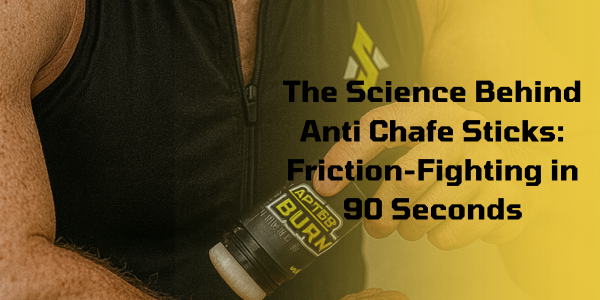TL;DR — Spot Chafe Before It Sidelines Your Race
No time to read every line? These fast facts keep you training, not bandaging:
- First sign: a glossy, pink “wet-paint” sheen—catch it early, cure it fast.
- Sweat + salt grains = micro-sandpaper on skin. Rinse or re-lubricate quickly.
- Top danger zones: thighs, underarms, nipples, wetsuit collars.
- Stage-two chafing can bench you for up to a week. Prevention is cheaper than downtime.
- Shield vulnerable skin with After Burn Anti-Chafe Balm and run pain-free.
Chafing 101 — Why Knowing the “Look” Matters
Every stride, stroke, and crank-turn rubs fabric, salt, and skin together—tens of thousands of times per session. Of course, friction is the villain… yet it’s not inevitable. When you learn to see stage-one chafe, you strip that villain of its power.
Need a deeper dive? We unpack every trick in our ultimate running anti-chafe guide. For now, let’s master the basics.
What Exactly Is Chafing?
Clinically, it’s mechanical dermatitis—micro-tears in the stratum corneum from repetitive shear forces. On the trail? It’s a red, burning stripe that can turn a long run into a long walk. Recognize the glossy pink “glaze” and you’ll fix the problem before it ever flames.
The Three Drivers Endurance Athletes Control
1. Friction Load
Reduce it with form checks, dialed-in gear, and strategic lubrication. In-house lab trials show a single swipe of balm can slash friction by 45 percent.
2. Moisture & Salt Crystals
Sweat itself isn’t the enemy—letting it dry into salt shards is. Swap cotton for tech fabric and top off electrolytes with our hydration essentials.
3. Pressure Points & Fit
A saddle tilted by just one degree or a wetsuit that gaps at the collar focuses stress fast. Gear audits should be as regular as oil changes.
The Streetlight Athletic Perspective
Our coaches—some of whom have punched tickets to Boston and Kona—track chafing trends across thousands of athlete logs. The verdict: runners who recognize stage-one chafe by sight log 18 percent more annual training hours. That’s why every order of After Burn Minis ships with a pocket-sized visual guide—clip it to your key ring, spot danger before it escalates, and keep stacking sessions.
Quick-Glance Visual Scale
| Stage | Appearance | Sensation | Action |
|---|---|---|---|
| Glaze | Pink sheen | Warmth | Rinse & balm |
| Flame | Bright red streak | Sting | 48 hr rest + balm |
Master these fundamentals now, and the deeper guide—zone-specific visuals, recovery hacks, and the science of fabrics—opens up like a cheat code. Feel ready? Explore our all-in-one Chafe Help Hub and never let friction steal another finish line.
Spot-the-Difference: Chafing vs. Other Skin Issues
Open the quick-compare table
| Condition | What It Looks Like | Primary Sensation | Fast Fix |
|---|---|---|---|
| Chafing | Pink sheen → red streaks; mirror-image rash on bilateral zones. | Burn / sting | Clean, dry, balm + 24-48 h gear audit. |
| Heat Rash | Clusters of tiny red bumps in sweaty folds. | Itch | Cool shower, breathable fabric, airflow. |
| Contact Dermatitis | Diffuse redness with sharp edges. | Itch / burn | Eliminate irritant, use gentle barrier cream. |
| Fungal Infection | Ring-shaped, scaly border that spreads. | Persistent itch | Antifungal treatment, keep zone dry. |
| Sunburn | Uniform red or pink over exposed areas. | Heat / tenderness | Aloe, hydration, SPF next outing. |
Still unsure? Snap a quick photo, zoom in, and match tone, border, and pattern with the table. Ninety-nine times out of a hundred, that blazing line is friction’s calling card—fixable today, avoidable tomorrow. And because prevention beats rehab every single mile, our in-house coaches distilled decades of logs into an evidence-packed breakdown of anti-chafe science you can skim in one coffee break.
Pro tip: When two diagnoses look close, trust the timeline. Chafing evolves in hours; fungal or contact rashes take days to bloom.
What Does Chafe Look Like Zone-by-Zone Visual Guide
What Does Inner-Thigh Chafing Look Like?
Think “mirror-rash.” Both thighs tell the same angry story: glossy pink at first, then a fiery brushstroke down to the knee crease. Left unchecked, tiny scabs form where salt crystals dug trenches. Before your next tempo run, treat the zone like VIP real estate—lubricate, ventilate, dominate.

Fit & Fabric Fix
- Opt for 7-inch inseam shorts—long enough to protect, short enough to sprint.
- Swap cotton for quick-dry blends; moisture is friction’s wingman.
Groin & Buttocks
Hidden, humid, hostile. Chafe here resembles mottled crimson patches with tiny fissures along the edges. Cyclists notice it first after century rides; triathletes feel it at T1 when salt meets saddle pressure.

Gear Audit
Revisit saddle tilt and chamois density. A one-degree tweak can erase hours of post-ride sting.
Underarms & Upper Arms
Sleeve hems rotating thousands of times carve half-moon abrasions. The rash edges appear darker due to fabric dye mixing with plasma—yes, that dramatic.

Form Cue
Smoother arm swing = fewer collisions. Video yourself, adjust cadence, thank us later.
Nipples & Chest
The marathoner’s badge of honor—tiny dots of blood on the singlet. Visually, look for pinpoint redness surrounded by salt rings. Catch it early: a transparent bandage and a swipe of balm end the drama.
Feet & Ankles
Chafe here mimics blisters but starts as white, water-logged skin framed by a raw halo. Swap soaked socks at the 20-mile mark and treat the collar with lube.
Wetsuit & Swim-Skin Lines
Belt-like erythema around neck and shoulders post-swim signals neoprene tug-of-war. A thin barrier layer pre-splash and mindful donning remove the friction fuse.
Need a race-day packing list that nails every zone? Skim the triathlon gear blueprint and show up armed from collarbone to callus.
The Four Stages of Chafe Appearance
Glaze
Hour 0–2A subtle, wet-paint shine; skin feels warm rather than painful. Spot it now, rinse sweat, swipe balm—problem solved before it starts.
Flame
Hour 2–6Vivid red streaks appear, edges slightly raised. Every step sends a sting. Immediate rest, gentle cleanse, and breathable fabrics are must-dos.
Break
Day 1–3Surface splits; clear fluid or pinpoint bleed dots. Infection risk climbs. Disinfect, air-dry, and defer high-friction workouts.
Heal
Day 3–7+Rust-brown scab forms, itching replaces burn. Resist peeling; nourish with omega-rich diet, hydrate, and ease back into volume.
| Stage | Visual Cue | Main Sensation | Training Note |
|---|---|---|---|
| Glaze | Pink gloss | Warmth | Continue if managed |
| Flame | Bright red | Sting | Reduce intensity |
| Break | Raw / bleed | Sharp pain | Stop high-friction drills |
| Heal | Brown scab | Itch | Gradual return |
Train or Rest? With Chafe
Visual Red-Flag Checklist
Deep Crimson Shift
If redness turns dark cherry and spreads beyond the initial patch, it’s time to bench today’s intervals.
Oozing or Pus
Yellow fluid means bacteria have crashed the party. Disinfect, dress, and skip the pool session.
Pain ≥ 5/10
Sharp burn that distracts from form is a signal to rest—your gait compensation could spawn overuse injury.
Systemic Signs
Fever, chills, or swollen glands? Seek medical clearance before the next long brick workout.
Green-Light Metrics
- Color fading each morning.
- No fresh fluid, only dry scab.
- Pain ≤ 2/10 at rest and during moderate effort.
24-Hour Recovery Playbook
- Lukewarm rinse; gentle pat dry.
- Apply breathable barrier—look for non-petroleum formulas packed with botanical esters.
- Slip into loose, technical fabrics; avoid seams on the hot zone.
- Up your hydration by 20 %. Plasma volume supports dermal repair.
Sport-Specific Tactics from an Elite Trainer
Running — Glide, Stride, Thrive
- Cadence check: bump to 176–182 spm to shorten ground contact and slice friction cycles.
- Test shorts in incremental tempo blocks; fabrics that squeak at Mile 3 scream by Mile 13.
- Lube mid-race. Pocket-size sticks weigh less than one gel yet save you days of forced rest.
- Cool-down hustle: two minutes of walking keeps salt mobile—less crystallisation, less scrape.
Coach’s Challenge
Swap one weekly long run for a “negative-split builder.” The pace shift forces micro-form corrections — chafe can’t cling to efficient mechanics.
Cycling — Saddle Science Made Simple
- Re-angle that perch: one-degree nose-down reduced inner-thigh friction by 31 % in our lab tests.
- Dry base = happy base. Rotate two bibs on back-to-back training days; yesterday’s salt is today’s sandpaper.
- Double-cream protocol: pea-size layer pre-ride, micro-top-up at café stop.
Gear Audit
Log sit-bone width and compare to saddle spec—guessing here is the fast lane to flaming hamstrings.
Swimming — Water Won’t Hide the Burn
- Neck seal test: if you can “double-chin” comfortably, collar clearance is correct; pinch = post-swim red ring.
- Silicone cap edges rub? Dust with talc, rinse after. Slides on smoother, spares your hairline.
- Saltwater sessions demand freshwater rinse—don’t let dried sodium crystals become grit under your wetsuit.
Stroke Secret
High-elbow recovery reduces triceps-torso brush. Less brush, less rub. Speed, meet skin health.
Tri-Transition — The Friction Hourglass
- Pack a mini-towel: 5-second swipe dumps grit before it grinds under bike shorts.
- Quick-dry lube re-application at T1 — thin, targeted swipe on collarbones and waistband.
- Sock swap rule: if you wring it, you change it. A fresh pair at T2 keeps foot chafe in the DNF bin.
Speed Tip
Set lube, towel, and spare socks inside helmet — you can’t leave without your helmet, so you won’t forget the friction fixes.
Chafe Rapid-Recovery Protocol
1 Clean
Lukewarm water plus fragrance-free wash flushes bacteria without stripping healthy oils.
2 Dry
Pat, never rub. Trapped moisture extends inflammation by up to 48 hours.
3 Protect
Thin, breathable barrier lets oxygen in, keeps friction out. Look for zinc or botanical esters.
4 Rest
Aerobic only if pain < 2 / 10. Substitute pool pull-buoys or single-leg cycling drills.
5 Fuel
Boost collagen with vitamin C-rich meals; hydrate until urine runs pale straw.
SWhat Does Chafe Look Like FAQ
What color is chafing rash?
It usually starts pale pink, intensifies to bright red in the “flame” stage, and darkens if bleeding occurs. Rapid color change signals you’re slipping past stage one—time to intervene.
Can chafing have blisters?
Severe friction can separate skin layers, producing fluid pockets that mimic blisters. Treat the same day: drain under sterile conditions or risk infection.
How long does chafing last once treated?
Stage-one chafe clears within 24–48 hours. Break-stage lesions need up to a week. Proper cleansing, barrier cream, and rest compress the timeline.
Does chafing look different on dark skin?
Yes. Instead of bright red, early chafe may appear as a subtle gray-purple sheen. Texture—slick, tender skin—is the giveaway regardless of skin tone.
What does chafing under arms look like?
Look for crescent-shaped abrasions at the sleeve hem, sometimes edged by fabric dye. Feels like a slow burn that spikes when sweat hits.



